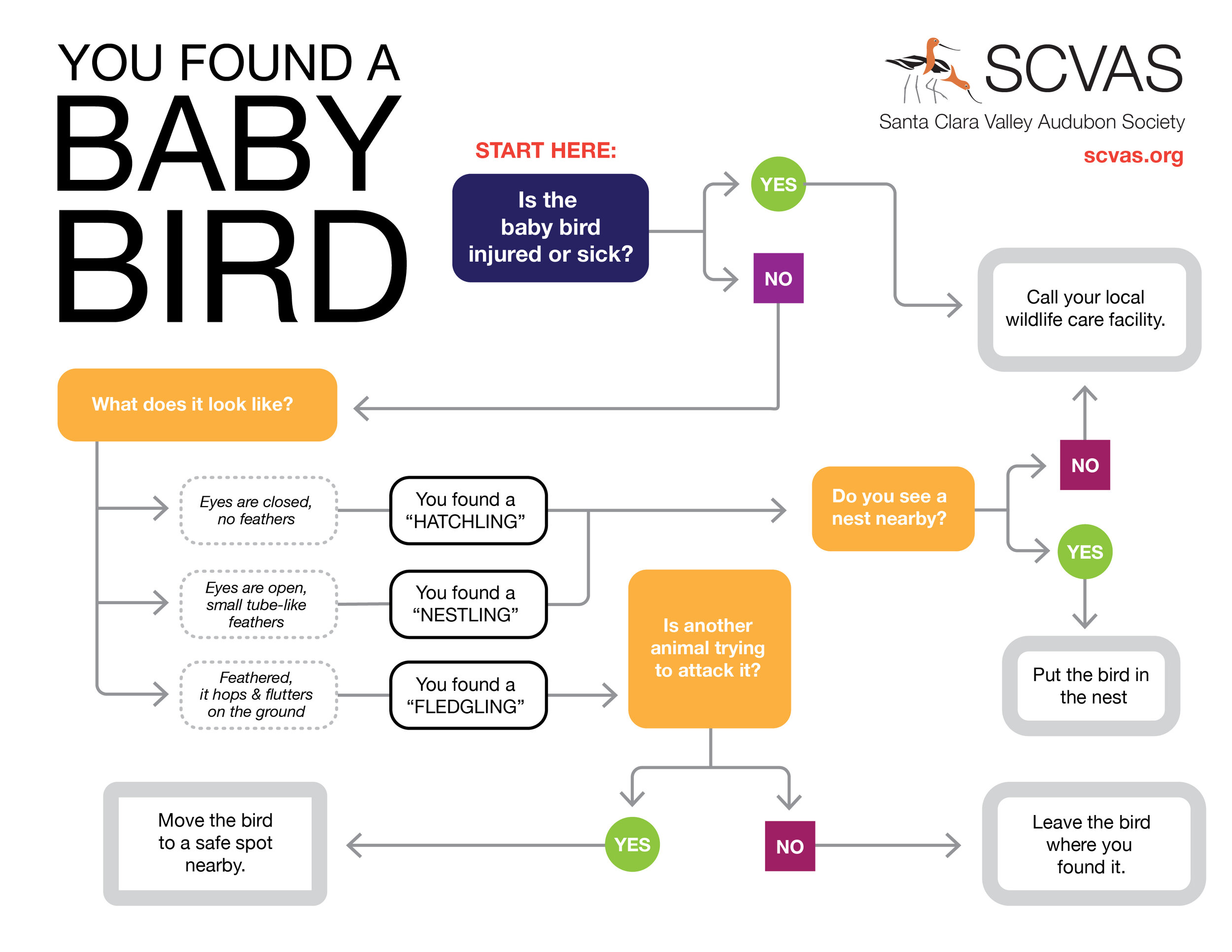BABY BIRDS OUT OF THE NEST
You’ve spotted a baby bird alone on the ground. Is there a problem, and should you do something?
Sometimes baby birds need our help, but often, they don’t. It’s important to allow wild birds to raise their young, and only intervene when necessary.
Refer to our flowchart below to help you decide if a baby bird needs help, or call a wildlife rescue center for advice.
Learn all about baby birds, and the in’s and out’s of wildlife rescue, in the following FAQ.
I’ve found a baby bird on the ground. Is there a problem?
Not necessarily. Feathered young birds, known as “fledglings”, spend time alone on the ground as they are developing their flying and foraging skills - this is normal, natural behavior. In many cases, the parents are still nearby and caring for them, even if you do not see adult birds.
If fledglings are healthy and safe, they do not need help, and you should keep your distance and leave them alone.
See “Identifying Baby Birds” below for more information about what fledglings look like, and the different developmental stages of baby birds.
When might a baby bird need help?
Baby birds may need help if they are:
too young to survive outside of the nest
sick or injured
in danger of being attacked by another animal or hurt by human
How can I figure out if a baby bird needs help, and what to do if it does?
Please refer to our flowchart above to determine if a bird needs help, and follow the instructions that match your situation. A list of local wildlife care facilities can be found here.
Young Northern Mockingbirds with one of their parents
Why is it important to intervene only when necessary?
Baby birds stand the best chance of surviving to adulthood when they are raised by their parents. They learn critical survival skills from their parents, like how to find food and water, and how to avoid predators. While humans can help in some cases, we cannot raise baby birds as well as their parents can.
Why shouldn’t I try to raise a baby bird on my own?
Besides being illegal to keep most wild birds, it takes special resources and skills to successfully raise a baby bird. Without special food, training, and care, wild birds raised in captivity usually do not survive long, and often have health and behavioral problems. Do not attempt to raise a baby bird on your own.
Please be aware that it is against the law to possess most species of wild birds in the United States without a permit. If you believe that a bird needs help, contact an authorized wildlife rescue center for advice.
identifying baby Birds
Northern Mockingbird juvenile - these birds, like many songbirds, are altricial
Most baby songbirds - like young finches, juncos, and chickadees - are altricial, meaning that they are completely dependent on their parents for the first few weeks of their life for food, warmth, and protection. When they hatch, they don’t have feathers, but develop them within a few weeks.
Canada Goose chick - these birds are precocial
Babies of some types of birds, like ducks and geese, are precocial. This means that when they hatch, they have feathers and are quite independent, able to walk and forage for food within a few hours or days. Parental care is still important, but they are not as dependent on their parents for survival as altricial chicks are.
How can I tell if a baby songbird is a hatchling, nestling, or fledgling?
Oak Titmouse hatchlings - their eyes are closed, and they are mostly naked, except for some wisps of down.
A hatchling is a newly hatched baby bird. Its eyes will be closed. It will usually not have feathers (it may have a bit of fluffy down on its body). A hatchling needs to be in a nest and cared for by its parents.
Oak Titmouse nestlings - these birds have developed feathers and are almost ready to leave the nest. Notice that some of their feathers resemble pins.
A nestling is older than a hatchling, but still needs to be in a nest and cared for by its parents. A nestling’s eyes will be open, and you may see what look like tubes or pins on its body - these are feathers that have not unfurled yet.
Northern Mockingbird juvenile, fledgling stage or after - the bird is fully feathered, but still has a short tail and short wings.
A fledgling is older than a nestling, and is a young bird that has left the nest and begun developing the skills it needs to care for itself. These birds are fully feathered, but often have different colors and patterns than adult birds. Their tails and wings may also seem short.
Fledglings may not be able to fly for up to five days, and you will see them walking, hopping, and fluttering on the ground. Often they are still being cared for by parents, even if you do not see adult birds.
Oak Titmouse fledgling, within a day of leaving its nest - it is fully feathered, but note the short wings and tail.
Questions?
Contact us at backyardbirds@scvas.org.
More Information
What to do if you find a baby bird - Portland Audubon
Baby birds out of the nest - Massachusetts Audubon
References
The Cornell Lab of Ornithology Handbook of Bird Biology, third edition: Irby J. Lovette and John W. Fitzpatrick, Editors. Published by John Wiley & Sons, 2016.
Credits
Infographic adapted by SCVAS, with permission, from Portland Audubon
Text by Julie Amato
Photos - Northern Mockingbirds, including banner photo, and Canada Goose by Julie MacKinnon
Photos - Oak Titmice by Jennifer Oliver









